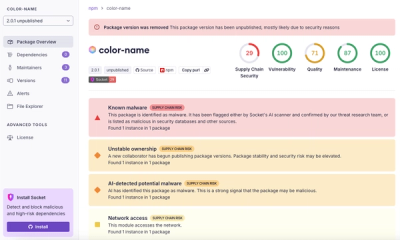
Research
/Security News
npm Author Qix Compromised in Major Supply Chain Attack
npm author Qix’s account was compromised, with malicious versions of popular packages like chalk-template, color-convert, and strip-ansi published.
python-twitter
A simple Python wrapper for Twitter API v2 :sparkles: :cake: :sparkles:.
.. image:: https://img.shields.io/endpoint?url=https%3A%2F%2Ftwbadges.glitch.me%2Fbadges%2Fv2 :target: https://developer.twitter.com/en/docs/twitter-api :alt: v2
.. image:: https://github.com/sns-sdks/python-twitter/workflows/Test/badge.svg :target: https://github.com/sns-sdks/python-twitter/actions :alt: Build Status
.. image:: https://codecov.io/gh/sns-sdks/python-twitter/branch/master/graph/badge.svg :target: https://codecov.io/gh/sns-sdks/python-twitter :alt: Codecov
.. image:: https://img.shields.io/pypi/v/python-twitter-v2.svg :target: https://pypi.org/project/python-twitter-v2/ :alt: PyPI
Twitter has published new version Twitter API V2 <https://twitter.com/TwitterDev/status/1293593516040269825>_ for developer at Aug 13, 2020.
This library provides a service to easily use this new version Twitter API.
You can get all API descriptions Twitter API v2 Documentation <https://developer.twitter.com/en/docs/twitter-api>_.
Docs for this library on here <https://sns-sdks.github.io/python-twitter/>_
You can install this library easily by pypi:
.. code-block:: shell
$ pip install python-twitter-v2
Code is hosted at https://github.com/sns-sdks/python-twitter <https://github.com/sns-sdks/python-twitter>_.
Checkout latest development version with:
.. code-block:: shell
$ git clone https://github.com/sns-sdks/python-twitter.git
$ cd python-twitter
Install dependencies with:
.. code-block:: shell
$ make env
Run tests with:
.. code-block:: shell
$ make test
Run tests with coverage:
.. code-block:: shell
$ make cov-term
$ make cov-html
The API is exposed via the pytwitter.Api class.
Now covers these features:
Tweets
Users
Usage
Trends
Spaces
Direct Messages
Lists
Compliance
Media Upload
You can initialize with an bearer token:
.. code-block:: python
>>> from pytwitter import Api
>>> api = Api(bearer_token="Your bearer token")
With OAuth 1.0A user context token:
.. code-block:: python
>>> api = Api(
consumer_key="consumer key",
consumer_secret="consumer secret",
access_token="access token",
access_secret="access secret"
)
Or with authorization done by user:
.. code-block:: python
>>> api = Api(consumer_key="consumer key",consumer_secret="consumer secret",oauth_flow=True)
# get url for user to authorize
>>> api.get_authorize_url()
# copy the response url
>>> api.generate_access_token("https://localhost/?oauth_token=oauth_token&oauth_verifier=oauth_verifier")
{'oauth_token': 'oauth_token',
'oauth_token_secret': 'oauth_token_secret',
'user_id': '123456',
'screen_name': 'screen name'}
Twitter has announced OAuth 2.0 user authentication support with fine-grained scopes <https://twittercommunity.com/t/announcing-oauth-2-0-general-availability/163555>_
Now if you have app with OAuth2.0 client ID. you can do authorize with OAuth2.
.. code-block:: python
>>> api = Api(client_id="You client ID", oauth_flow=True)
# get the url and code verifier for user to authorize
>>> url, code_verifier, _ = api.get_oauth2_authorize_url()
# copy the response url
>>> api.generate_oauth2_access_token("https://localhost/?state=state&code=code", code_verifier)
{'token_type': 'bearer',
'expires_in': 7200,
'access_token': 'access_token',
'scope': 'users.read tweet.read',
'expires_at': 1631775928}
You can get information about a user or group of users, specified by a user ID or a username.
Get group of users:
.. code-block:: python
# By ids
>>> api.get_users(ids=["783214", "2244994945"])
Response(data=[User(id='2244994945', name='Twitter Dev', username='TwitterDev'), User(id='783214', name='Twitter', username='Twitter')])
# By username
>>> api.get_users(usernames="Twitter,TwitterDev")
Response(data=[User(id='2244994945', name='Twitter Dev', username='TwitterDev'), User(id='783214', name='Twitter', username='Twitter')])
Get single user:
.. code-block:: python
# By id
>>> api.get_user(user_id="783214")
Response(data=User(id='783214', name='Twitter', username='Twitter'))
# By username
>>> api.get_user(username="Twitter")
Response(data=User(id='783214', name='Twitter', username='Twitter'))
Get user following:
.. code-block:: python
>>> api.get_following(user_id="2244994945", max_results=5)
Response(data=[User(id='459860328', name='julie✨', username='JulieMendoza206'), User(id='273830767', name='🄿🅄🅂🄷', username='rahul_pushkarna')...])
Get user followers:
.. code-block:: python
>>> api.get_followers(user_id="2244994945", max_results=5)
Response(data=[User(id='715131097332518912', name='Daniel', username='RGIDaniel'), User(id='1176323137757048832', name='Joyce Wang', username='joycew67')...])
You can follow or unfollow user if you have User context.
follow user:
.. code-block:: python
>>> api.follow_user(user_id="123456", target_user_id="654321")
{'data': {'following': True, 'pending_follow': False}}
unfollow user:
.. code-block:: python
>>> api.unfollow_user(user_id="123456", target_user_id="654321")
{'data': {'following': False}}
You can get information about a tweet or group of tweets by tweet id(s).
Get single tweet:
.. code-block:: python
>>> api.get_tweet("1354143047324299264", expansions=["attachments.media_keys"], media_fields=["type","duration_ms"])
Response(data=Tweet(id=1354143047324299264, text=Academics are one of the biggest groups using...))
Get group of tweets:
.. code-block:: python
>>> api.get_tweets(["1261326399320715264","1278347468690915330"],expansions="author_id",tweet_fields=["created_at"], user_fields=["username","verified"])
Response(data=[Tweet(id=1261326399320715264, text=Tune in to the @MongoDB @Twitch stream...), Tweet(id=1278347468690915330, text=Good news and bad news: 2020 is half over)])
For Streaming, this provide StreamApi independent. Same as main Api, You need initialize it first.
.. code-block:: python
>>> from pytwitter import StreamApi
>>> stream_api = StreamApi(bearer_token="bearer token")
# or use consumer key and secret
>>> stream_api = StreamApi(consumer_key="consumer key", consumer_secret="consumer secret")
For Sample Stream tweets, you can use the sample_stream function to build a connection.
.. code-block:: python
>>> stream_api.sample_stream()
For Filtered Stream, you can create rules.
Get your current rules.
.. code-block:: python
>>> stream_api.get_rules()
Response(data=[StreamRule(id='1369580714056843266', value='twitter api ')])
Delete your rules.
.. code-block:: python
>>> stream_api.manage_rules(rules={"delete": {"ids": ["1369580714056843266"]}})
Response(data=[])
Add new rules. If you set dry_run to True, will only validate rules, and not create them.
.. code-block:: python
>>> np = {
"add": [
{"value": "cat has:media", "tag": "cats with media"},
{"value": "cat has:media -grumpy", "tag": "happy cats with media"}
]
}
>>> stream_api.manage_rules(rules=np, dry_run=True)
Response(data=[StreamRule(id='1370406958721732610', value='cat has:media -grumpy'), StreamRule(id='1370406958721732609', value='cat has:media')])
Then you can use search_stream to get tweets matching your rules.
.. code-block:: python
>>> stream_api.search_stream()
You can go to the Example folder <examples>_ for streaming examples.
FAQs
A simple Python wrapper for Twitter API v2 ✨ 🍰 ✨
We found that python-twitter-v2 demonstrated a healthy version release cadence and project activity because the last version was released less than a year ago. It has 1 open source maintainer collaborating on the project.
Did you know?

Socket for GitHub automatically highlights issues in each pull request and monitors the health of all your open source dependencies. Discover the contents of your packages and block harmful activity before you install or update your dependencies.

Research
/Security News
npm author Qix’s account was compromised, with malicious versions of popular packages like chalk-template, color-convert, and strip-ansi published.

Research
Four npm packages disguised as cryptographic tools steal developer credentials and send them to attacker-controlled Telegram infrastructure.

Security News
Ruby maintainers from Bundler and rbenv teams are building rv to bring Python uv's speed and unified tooling approach to Ruby development.